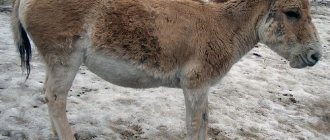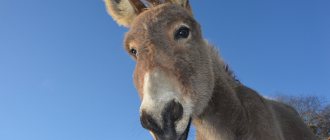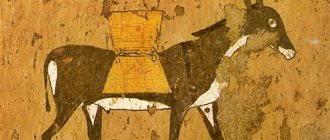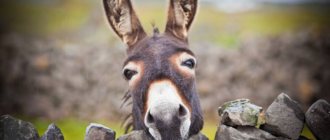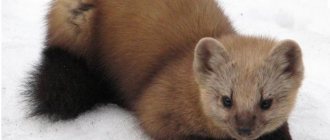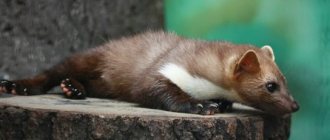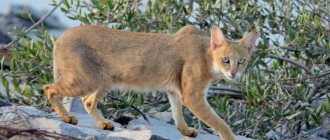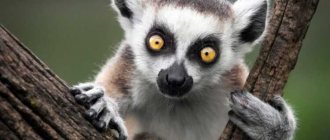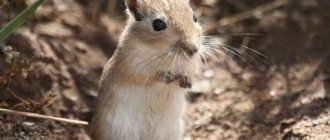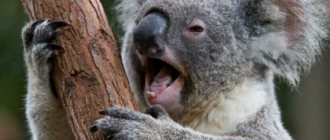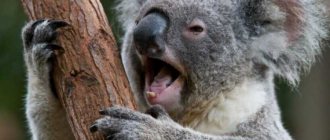In this article we will analyze how a mule and a donkey differ, what they look like and what features are characteristic of each of them.
There are several thousand different animals in the world. They all have their own characteristics and different body structures. With the evolutionary development, many of them were tamed, and they have become familiar pets to us today. In addition, many animals began to be used as farming assistants.
In many countries, mules, donkeys and donkeys helped transport cargo to the most remote areas, helping to establish trade and economic ties between regions. We will analyze how these animals differ, what they look like and what features are characteristic of each of them.
Donkey and donkey - what's the difference?
Many people have heard and even seen animals such as donkey and donkey since childhood, but never thought about how similar they are. What is the difference between a donkey and a donkey? In fact, this is the same name for a donkey. The only difference is that a donkey can be called both a wild and domesticated animal, and the name “donkey” is applicable only to a domestic one.
The word "donkey" comes from the Latin language, in which it means a small horse. Indeed, the donkey has many features similar to those of the horse. However, it is distinguished by its large ears, short stature and characteristic cry of “ee-ah”.
The word “donkey” comes from the Turkic language. In Arab countries, this is what they began to call a domesticated donkey, which was adapted for transporting goods.
Therefore, it is quite easy to understand the difference between a donkey and a donkey - according to affiliation and gender. It is popularly believed that a donkey is a male animal, and a donkey is a female animal.
Additionally, these animal names are sometimes applied to humans. Thus, a donkey is a person who has low intelligence, and a donkey is a hard worker who works for little pay. Both words are considered swear words.
Origin of words
Even today, no one has exact information about how the word “donkey” appeared, nor is it true that only experts know how long donkeys live. There is a hypothesis put forward by some scientists that the basis for this word was the Latin Asinus. Experts do not have an exact translation ; they can only say in general what it means. We are talking about small animals that resemble a horse with hooves that periodically emit a strong roar.
If we turn to the history of the origin of the word “donkey”, we can see a close connection with the Turkic languages. And in the description you can immediately recognize exactly the animal that many of us associate with a donkey. Biologists have an assumption that the donkey is a descendant of Somali ancestors. And therefore, since those ancient times, this animal has served as a faithful assistant to man on the farm.
Historians did not stand aside either. According to them, the first representatives of this species appeared in northern Africa. It was from there that they began to gradually spread to the Middle East and Asia.
Interesting Facts
There are a number of interesting facts about these animals with large ears:
- The donkey became the first domesticated animal. 5000 years ago, the Egyptians were the first to domesticate it and began to use it for household needs;
- animals are able to survive even in the harshest conditions, for example, being in a hot desert for a long time without food and water;
- young animals are accustomed to work from the age of 2; upon reaching the age of 3, animals are used to carry small loads, the weight of which can gradually increase;
- Donkeys are independent from birth, and at the age of 2 years they can have offspring.
It is also interesting that in every corner of the world the animal has its own name. In Russia it is called both a donkey and a donkey, there is no difference. There is also a single Latin name - Equus asinus, which is often used in the scientific world.
What is the name of a female donkey?
Female animals of this group have a number of features in their designations:
- Traditionally, the term “ass” was used to refer to a female donkey. However, in the sixteenth century in Russia they began to use the word “donkey”, which is of Turkic origin. This concept was used to designate the females of these animals.
- Previously the word had been applied only to all African varieties domesticated by humans.
- The female mule sounds like "mule".
Benefits for humans
After domestication, the donkey and donkey began to be used for economic purposes. This is due to the great endurance of the representative of the equine family and the ability to carry large loads, which is why it is sometimes called a pack animal.
The animal is used to produce milk, which is considered healthy and nutritious, and also has anti-aging properties. Donkey milk is similar in composition to women's breast milk, which is why even in ancient times babies were supplemented with just this product. Moreover, as a vehicle the donkey is just as good.
A little history
For the first time, information about donkeys appears in historical documents around the 15th century BC. Nubian donkeys were used to transport goods in the Nile Delta; information about small pack animals is also found on the tablets of Mesopotamia. The predecessors of Roman civilization, the Etruscans, also mention donkeys. In ancient Egypt, the donkey was the symbolic animal of the god Set.
The myths of ancient Greece are literally filled with donkeys, and these animals were considered a model of stubbornness and courage. The difference between the Greek image of the donkey and its symbolism during the Roman Empire is almost radical. In Rome, the donkey becomes an emblem of lust, greed and stupidity, and the first caricatures of early Christianity depicted crucified donkeys.
By the way, there is an ironic ancient Roman novel in 11 books, written by Apuleius, called “Metamorphoses” (or “The Golden Ass”), where a donkey, or rather the main character Lucius, turned into a donkey, becomes the central character of the story. And he turned because of a life replete with sensual pleasures (described in detail on the pages of the novel) and temptations of life, which brought him to a “bestial” state.
In the guise of an animal, the guy finds himself in the service of different masters, works exhaustingly, goes hungry and sees the life of various strata of society from the inside, everywhere observing the decline of morals. You can read about this ancient work on Wikipedia.
In mythology, King Midas receives donkey ears as punishment; long ears are part of a jester's cap. Donkeys helped Dionysus in his gigantomachy; they were sacrificed to the god of war Ares; Silenus rode a donkey and the giant Typhon escaped from the wrath of the gods. In a word, in ancient civilization the well-known donkey was a well-known figure and was actively used in art, farming, and even in wars. By the way, the incomparable Cleopatra made herself baths from donkeys’ milk.
In Christianity, the donkey becomes a symbol of modesty, patience, humility and poverty. It was on a donkey that Mary traveled to Bethlehem, and Christ entered Jerusalem, the capital of Israel - this is an immutable historical fact.
In different religions, the donkey personifies different qualities - in Judaism it is a symbol of stubbornness, in Buddhism it is the embodiment of asceticism and humiliation, the donkey is mentioned in the Koran as a symbol of stupid cowardice. Moreover, Islam prohibits eating the meat of domestic donkeys, but it is possible to eat wild ones.
In Russia in the 17th century, there was a church tradition - the Easter detour of the Patriarch of Moscow on a donkey. This animal was associated with Palm Sunday and St. Nicholas the Wonderworker. And yet, the domestic donkey was much more common in Asia, and it was there that it was persistently called the donkey, which the padishah himself did not disdain to ride.
The famous folklore character Khoja Nasreddin, the hero of a whole cultural layer of fairy tales, parables, sayings, humorous tales and anecdotes of the East, appeared everywhere riding on his beloved donkey, and so he is depicted in the form of numerous monuments - a funny man riding a donkey.
A vagabond and a freethinker, he is one way or another present in the culture of Turkey, China, Arab, Persian, Caucasian, Balkan and Central Asian literature. And he is always depicted riding a donkey, which often becomes the main character in stories about Hodge.
Mule
Donkey, donkey and mule - what's the difference? If donkey and donkey are different names for the same animal, then a mule is bred by man by crossing a mare and a donkey. The animal turns out to be similar to a horse, but long ears, hips and height give off donkey genes.
A mule, like a horse, has high performance, and is also unpretentious, like a donkey. This makes it possible to use the animal for agricultural purposes. The animal's lifespan is about 50 years, 40 of which the mule is able to work. Unfortunately, such a hybrid is rarely capable of reproduction.
Mules are also adapted to serve as vehicles for transporting people. At the same time, the soft step of the animal does not tire the traveler at all, even after a long trip.
Reproduction
Breeding season
Females become sexually mature at 1.5 years of age, but most do not breed until they are 2-3 years old. The most fertile age class of females is 4-year-old individuals, but females breed up to 14 years of age. All males reach sexual maturity by 2 years.
Photo: Ansgar Scheffold
Wild populations do not have a specific breeding season , however it usually peaks in late spring, although females are polysternous and mate at any time of the year. The longest period of estrus was 8 days. Populations in the United States breed during March–July; in Western Australia, more than 50% of conceptions occur between August and November, before the onset of the rainy season; no conceptions were recorded between February and July.
Mating activity gradually increases 2 days before females ovulate. Females in heat often adopt a copulatory posture, spreading their hind legs and holding their tail at a 45-degree angle. The male comes up from behind and sniffs the female's genitals. The female ritually kicks the male and moves away from him at a slow gallop. The male follows the female at a distance of 20 meters. Both soon stop and copulation occurs.
Cubs development
Pregnancy lasts 365-370 days . Females give birth to 1 or 2 foals. Foals begin to chew on plants at 5 days of age, but weaning does not occur until 12-14 months later.
The female spends most of the first day after giving birth within 1 meter of the foal. She does not allow other individuals to approach him and maintains almost constant tactile contact , touching and grooming the foal. During the month, the foal spends 71% of its time within 1 meter of its mother, and 35% of the time between 1 and 2 months of age. Even at one year of age, the foal still spends most of its time within 10 meters of its mother.
Genetics and crossing with other species
The wild ass is the ancestor of the donkey. All domesticated donkeys crossed with wild animals produce fertile offspring. The practice of crossing the donkey with other equids may be almost as ancient as its domestication.
The first equid bred to a domestic donkey was the onager. The earliest hybrid dates back to around 3000 BC. in Palestine. Later, when domestic horses were brought to Asia Minor from the north, domestic donkeys were crossed with them to produce mules. The large head and long ears of a mule resemble a donkey, and the body resembles a horse. A wild donkey is less commonly bred with a stallion to produce a usually sterile hinny. The small head and short ears of the hinny resemble a horse, and the body resembles a donkey.
Photo: PamWalker68
Hinny
In addition to the mule, there is another hybrid of a horse and a donkey - the hinny. It differs from a mule in that it is the offspring of a donkey and a stallion. The animal's appearance is more reminiscent of a donkey; only intelligence and tall stature are inherited from the horse. Despite the fact that the cross is successful, it is bred less frequently than mules, since hinnies are less hardy.
However, in past centuries, the hinny was very popular - in Europe there were several million animals adapted for agricultural work.
Animals are infertile from birth, however, it is customary to castrate them so that they are not distracted by horses of the opposite sex. In addition, they are difficult to breed, since horses and donkeys initially have different numbers of chromosomes.
We have already figured out what is the difference between a donkey and a donkey. Next, we will consider the question of where they are still in demand besides household use. These are excellent circus performers as they are easy to train. The animal's submissive disposition and small stature makes it possible to use it in children's equestrian sports, as well as for riding with a side saddle. Endurance and courage are encouraged in equestrian tourism. The donkey is able to travel long distances along mountain trails without fatigue (see photo).
What is the difference between a donkey and a donkey, you found out by reading the information in this article. Over many years of selection, many domestic breeds of donkey have been bred, which differ from each other in coat color, height and ear size. Animals also participate in agricultural exhibitions everywhere.
Breeding donkeys
The homeland of the wild donkey is Africa, and thanks to this, donkeys, unlike horses, tolerate the hot, arid climate much better. This is the main reason for the wide distribution of domestic donkeys in the hot countries of Africa and Asia. Later, donkeys were brought to other regions, even to Australia - they were popular everywhere.
In the first half of the 20th century, technological progress led to the appearance of cars and tractors. And this, in turn, led to the fact that the role of horses in the national economy lost its primary importance.
It would seem that the same thing should happen to donkeys. But no. The donkeys were saved, again, by the geographic location of their breeding regions. In simple words, donkeys were most popular in hot countries with mountainous terrain and poor economies. Progress certainly came there, but the money did not come. Residents of these countries simply cannot afford to buy expensive equipment, and not all equipment is capable of performing work in such conditions.
Therefore, in countries of a number of regions, such as Central and Central Asia, Africa and the Middle East, donkeys remain the most important draft force of the national economy today.
As for the developed countries of Europe and the USA, donkey breeding is carried out at the hobby level. True, there is also breeding of purebred donkeys for sale.
Keeping and breeding donkeys was considered a very profitable business. Cleopatra's cortege consisted of hundreds of donkeys, and she herself, according to legend, was not averse to bathing in pine milk to preserve her youth.
In Russia, the center of donkey breeding is Dagestan. The number of donkeys there is about 10 thousand heads.
The world population of domestic donkeys exceeds 40-50 million heads. Although, of course, no one has ever done an exact count.
